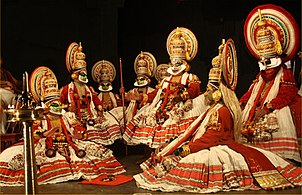This article has multiple issues. Please help improve it or discuss these issues on the talk page. (Learn how and when to remove these messages)
|
|
|
| Part of a series on the |
| Culture of India |
|---|
 |
Theatre of India is one of the most ancient forms of theatre and it features a detailed textual, sculptural, and dramatic effects which emerged in mid first millennium BC.[1][2] Like in the areas of music and dance, the Indian theatre is also defined by the dramatic performance based on the concept of Nritya, which is a Sanskrit word for drama but encompasses dramatic narrative, virtuosic dance, and music.[3][2] Historically, Indian theatre has exerted influence beyond its borders, reaching ancient China and other countries in the Far East.
With the Islamic conquests that began in the 10th and 11th centuries, theatre was discouraged or forbidden entirely.[4] Later, in an attempt to re-assert indigenous values and ideas, village theatre was encouraged across the subcontinent, developing in a large number of regional languages from the 15th to the 19th centuries.[5] Modern Indian theatre developed during the period of colonial rule under the British Empire, from the mid-19th century until the mid-20th.[6]
From the last half of the 19th century, theatres in India experienced a boost in numbers and practice. After Indian independence in 1947, theatres spread throughout India as one of the means of entertainment. As a diverse, multi-cultural nation, the theatre of India cannot be reduced to a single, homogenous trend.
In contemporary India, the major competition with its theatre is that represented by growing television industries and the spread of films produced in the Indian film industry based in Mumbai (formerly Bombay), known as "Bollywood". Lack of finance is another major obstacle.
- ^ Natalia Lidova (1994). Drama and Ritual of Early Hinduism. Motilal Banarsidass. pp. 111–113. ISBN 978-81-208-1234-5.
- ^ a b Kapur, Kamlesh (2010). History Of Ancient India (portraits of a Nation), 1/e. New Delhi: Sterling Publishers Pvt. Ltd. p. 483. ISBN 9788120752122.
- ^ Westlake, E.J. (2017). World Theatre: The Basics. Oxon: Routledge. p. 7. ISBN 9781138838055.
- ^ Brandon (1997, 72) and Richmond (1998, 516).
- ^ Brandon (1997, 72), Richmond (1998, 516), and Richmond, Swann, and Zarrilli (1993, 12).
- ^ Richmond (1998, 516) and Richmond, Swann, and Zarrilli (1993, 13).

